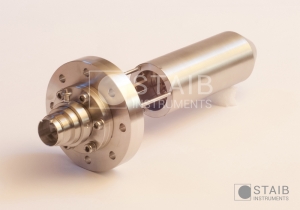 RHEED guns from STAIB Instruments are available as standard, short and super short designs and come with many different options and accessories.
RHEED guns from STAIB Instruments are available as standard, short and super short designs and come with many different options and accessories.
These systems are ideally suited for MBE growth with and without process gas, analytical RHEED, and other deposition systems with pressures up to 1 millitorr (1 x 10-3 Torr) for even higher pressures please see TorrRHEEDTM.
By combining electrostatic and magnetic elements, the gun produces a high brightness, small diameter, and low divergence beam, with extremely low outgassing. The gun mounts completely outside the chamber. The optics are prealigned and need no time consuming adjustment. The system is fully UHV compatible and bakeable. Operation at higher pressure is possible and, if necessary, an efficient differential pumping option is available.
Gun settings, energy, filament current, and beam intensity, are displayed using digital readouts. The power supply is remote controlled by a compact control box to adjust the beam intensity, focus, and position. The system is equipped with a diagnostic capability, which allows a quick and complete test of the RHEED system electronics.
Beam blanking is one such advantage. The beam can be switched on and off electrically by controlling electron extraction from the filament. This method avoids the generation of stray electrons.
The basic beam blanking option (standard on all STAIB RHEED systems), allows the beam to be turned on and off manually from the remote control box.
Additionally a full beam blanking option is available. Here the electron beam can be turned on and off using a TTL type input through a BNC connector.
The full beam blanking option can be used to keep the electron load on the sample very low. Electron bombardment of sensitive surfaces can be kept to a minimum. The blanking signal can also be triggered synchronously with external signals to improve the use of the electron source in the presence of stray magnetic fields by compensating their effect. The external trigger can also be utilized to synchronize with rotating samples, which is important for in situ monitoring in some deposition techniques.
The unique STAIB feature, beam rocking, allows precise adjustment and variation of the incidence angle using electronic controls, without moving the sample. Electron sources from STAIB Instruments are uniquely designed to allow this precise electronic control of the beam position using sophisticated electron beam deflection optics.
When equipped with the beam rocking option, specially designed optics shift the electron path off axis in the gun and refocus it onto the sample, maintaining the spot position. In this way, the incidence angle can be precisely controlled electronically without either modifications of the geometry of the gun or motion of the sample. The electron gun can be mounted on the vacuum chamber without using a bellows for mechanical adjustment. The beam rocking option is very helpful in critical cases where the sample position cannot be adjusted easily during the growth. In these cases, beam rocking allows precise variation of the incidence angle.
With the patented STAIB TorrRHEED™, the incident angel can be changed with a unique double deflection system. The beam can easily be manipulated on the substrate without changing the mechanical alignment. This gives the operator the desired degrees of freedom for easy and simple alignment of the RHEED setup. RHEED diffraction conditions can be quickly and reproducibly fine tuned at any time, without the cumbersome mechanical manipulation approach used by other manufacturers.
RHEED systems from STAIB Instruments are available with a differential pumping option for pressures greater than 10-5 mbar. By utilizing a turbo pump (>40 l/s) attached to a special flange on the electron gun, the system continues to work well up to a few 10-3 mbar. Efficient pumping of the filament section of the source offers unbeatable versatility. For higher pressures, the double differential pumping option (TorrRHEED™) is available, which still allows the complete electronic control of the beam.
The differential pumping option is available on all RHEED systems from STAIB Instruments in the range of 15 eV to 60 keV.
1: Power supply computer control plug
The electron source power supply is equipped with an optional computer connection plug for use with analog control signals. The electron source system can either be operated using the manual control dials, or by using the optional computer control. The control voltages can either be provided by 3rd party software through a suitable DAC interface, or by the STAIB computer control module.
2: STAIB computer control module
The STAIB computer control option includes the cables and microprocessor interface to connect to the power supply computer control plug. The STAIB software sends the input signals to the power supply to control the system functions. Full parameter sets can be stored, modified, and reused. The advanced version of the STAIB computer control module can retrieve and copy the adjusted values from the manual control dials, providing the user with previously unavailable ease of use.
The option runs under the WindowsTM XP, WindowsTM 7, WindowsTM 10 operating systems, using a USB connection.
RHEED computer control includes a microprocessor interface module and a software package, and makes use of the RHEED very precise and repeatable. User’s parameters can be saved and retrieved, the beam can be turned on and off using the beam blanking option, and the incidence angle can be adjusted using the optional beam rocking feature of the gun.
Regulation of the electron beam current to a fixed, precise, user-adjusted value is important when the electron gun is working in a higher pressure range and when using reactive gases in the vacuum chamber. Once adjusted, the BCC will regulate the beam current to the assigned value, even after gun parameters like beam energy or focus are modified. Operating values can be saved and will be kept after restarting the BCC module, ensuring identical experimental conditions.
